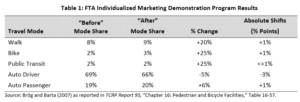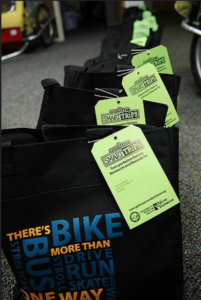Providing new infrastructure and new or improved services is a proven way to increase the number people walking, biking, or taking transit for their day to day travel, but new infrastructure or services shouldn’t be considered as standalone investments. To gain the most from our investments in sustainable transportation, we also need to reach out to people who live, work, and play in the areas served by those services/infrastructure and encourage them to use it.
Targeted marketing campaigns, or individualized marketing provide tailored outreach to educate people about their travel choices. This customized information allows each marketing program to focus on the unique travel needs of an individual neighbourhood, institution, or audience. It’s an effective way to bridge the information gap and support a change in travel behaviour — driving less and using alternative travel options more. In fact, it’s been shown to decrease the number of kilometers being traveled, especially when initiated alongside major transit service and/or infrastructure projects that make it easier to walk, bike, or bus.
For instance, a Portland study showed that areas targeted for individualized marketing after installation of a new rapid transit line saw a near doubling in the shift to transit use compared to a similar area not targeted by individualized travel marketing.[1][2] Households near the rapid transit line that hadn’t been reached by Smart Trips, their individualized marketing program cut car use by 3 percent. But those Smart Trips did contact reduced car use by 12 percent.[3]
As SmartTrips program manager Linda Ginenthal points out in a 2014 BikePortland.org article, “It cost us a million dollars to do the SmartTrips program,” she said. “And we spent many, many millions of dollars on light rail and it got us a 3 percent reduction in trips. You do the math.”[4]
The 2009 WinSmart Community Based Travel Marketing Pilot program (based on targeted/individualized marketing) showed that this type of program could be quite successful in Winnipeg. Results from the project showed an 11.7 per cent reduction in drive-alone and an 18.2 per cent reduction in trip-related CO2 emissions. This was supported by a 54.3 per cent relative increase in cycling, 3.4 per cent increase in walking and 8 per cent increase in carpooling. There was also a 5.4 per cent reduction in vehicle kilometres traveled (VKT).[5]
In Winnipeg, we are suggesting that the city launch an individualized marketing program that will reach 20,000 households per year, starting in 2020 with the opening of the Southwest Rapid Transit Corridor. Program planning would need to begin in 2019.
Footnotes
[1] Brög et al. as reported in TCRP Report 95. “Chapter 16: Pedestrian and Bicycle Facilities.” 2009. p. 16-220.
[2] Individualized Marketing Programs, Oregon Department of Transportation
[3] City’s ‘SmartTrips’ marketing program shifts focus, BikePortland.org, 2014
[4] City’s ‘SmartTrips’ marketing program shifts focus, BikePortland.org, 2014
[5] Section 7, WinSmart CBTM Project Report: WinSmart Community-Based Travel Marketing Pilot Project, Resource Conservation Manitoba, 2009

